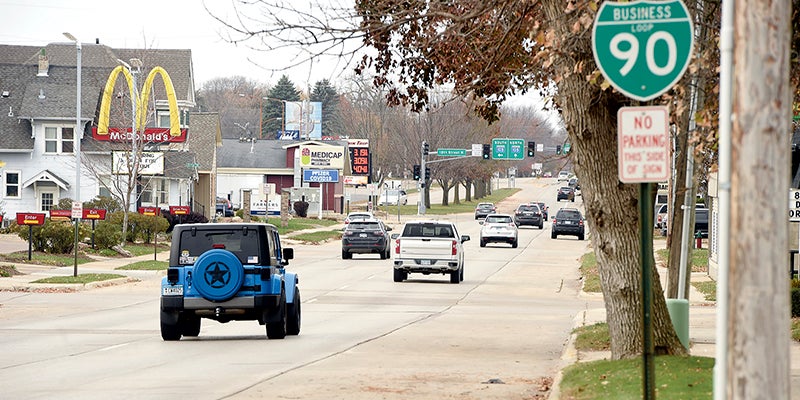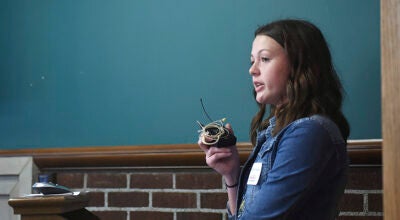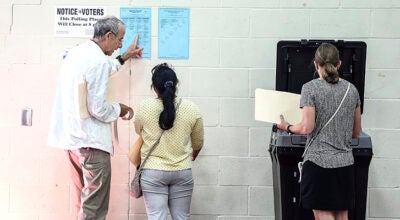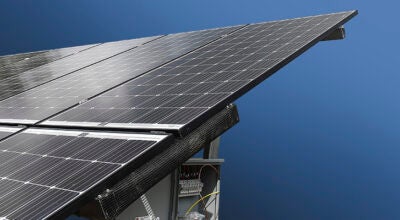Second meeting presents three new options for one-way reconstructions
Published 10:35 am Thursday, December 14, 2023

- Vehicles head west on Oakland Avenue West in November. The one way will be part of a large reconstruction project along with First Avenue starting in 2025. Herald file photo
|
Getting your Trinity Audio player ready...
|
Based on past input, city engineers and WHKS, the design firm drawing up plans for the upcoming Oakland Avenue and First Avenue one-way reconstruction, presented three new options for the mammoth three-year project Wednesday night.
Slated to begin construction in the spring of 2025, the project will replace a span of road on both one-ways totaling 25 blocks. The work will include Oakland Avenue from 12th Street NW to First Street NE and First Avenue SW from 12th Street SW to Main Street and will be done roughly in eight-block chunks each year.
Construction time for the project will stretch from 2025-2027 and will take place alongside much of the Minnesota Department of Transportation’s bridge replacement project on Interstate 90.
The three newest options look very similar to the existing layout of the roads, including one option that will rebuild the roads to existing specs: parking on both sides, maintaining road widths and have a five-foot sidewalk on both sides of the roads.
The other two options would be similar to the leave-it-alone option with some notable differences.
Option 2:
• Parking on both sides
• Narrow driving lanes by one foot
• Narrow parking lanes by 6 inches
• Eight foot sidewalks on the north side of Oakland Avenue and south side of First Avenue SW
• Standard five foot sidewalk width on the opposite side.
Option 3:
• Parking on both sides
• Narrow driving lanes by one foot
• Narrow parking lanes by six inches
• Six foot sidewalk on both sides.
These latest three options meet concerns raised by people during a first informational meeting held in early November where options presented there included taking out one side of parking, adjusting sidewalk widths to accommodate cyclists or possibly adding a dedicated lane for cyclists and narrowing the driving lanes to account for concerns regarding high speeds on the roadways.
Many of the people during the November meeting, though, thought that taking out parking would create challenges for those working and living along those stretches.
“It was pretty clear that people desire parking on both sides of the roads,” said Assistant City Engineer Mitch Wenum Wednesday night. “We’re listening to feedback we’ve received. Your voice is important in this process.”
However the idea of reducing the width of driving lanes is still included in two of the options as WHKS presenter Kyle Skov hearkened back to the earlier meeting and echoed that in similar projects, narrowing the roadways helped slow traffic.
What was missing from all three options was any discussion of the dedicated bike lane, which many feel is simply too dangerous on the thoroughfares.
Instead, options from this latest meeting lean more toward a shared sidewalk space for both pedestrians and cyclists.
However, an online survey conducted by the city still showed interest in accommodating cyclists, with 50% of the 361 people taking part wanting an off-street bike path, and 10% wanting a dedicated bike lane. Forty percent wanted no change at all.
At the end of the meeting, those attending were given raffle tickets and were encouraged to place them as part of an informal poll in three boxes that indicated which option they favored.
Information from both meetings and the online survey will be taken under consideration and will be presented to the Austin City Council at a later date.
According to the project schedule presented by Skov, preliminary design work is expected to start this month with a final design expected to be submitted in October of 2024.
The First Avenue part of the project was last paved in 1953, while the Oakland Avenue portion was last paved in 1978.
When completed, the project will replace:
• Deteriorated pavement;
• Replace underground utilities for improved service and reliability;
• Improve pedestrian access and meet Americans with Disabilities Act standards; and
• Increase bicycle accessibility and safety.
Visit here to follow the process of the project.





